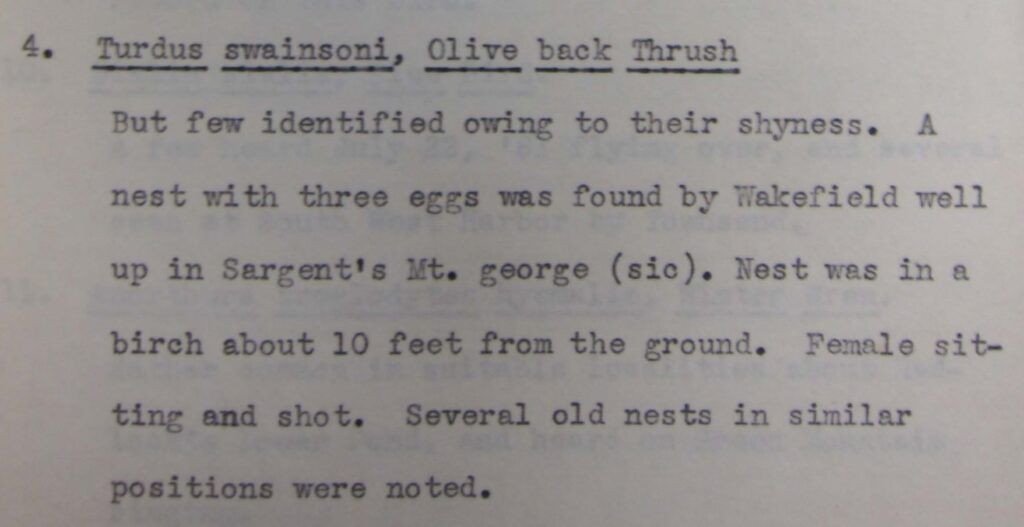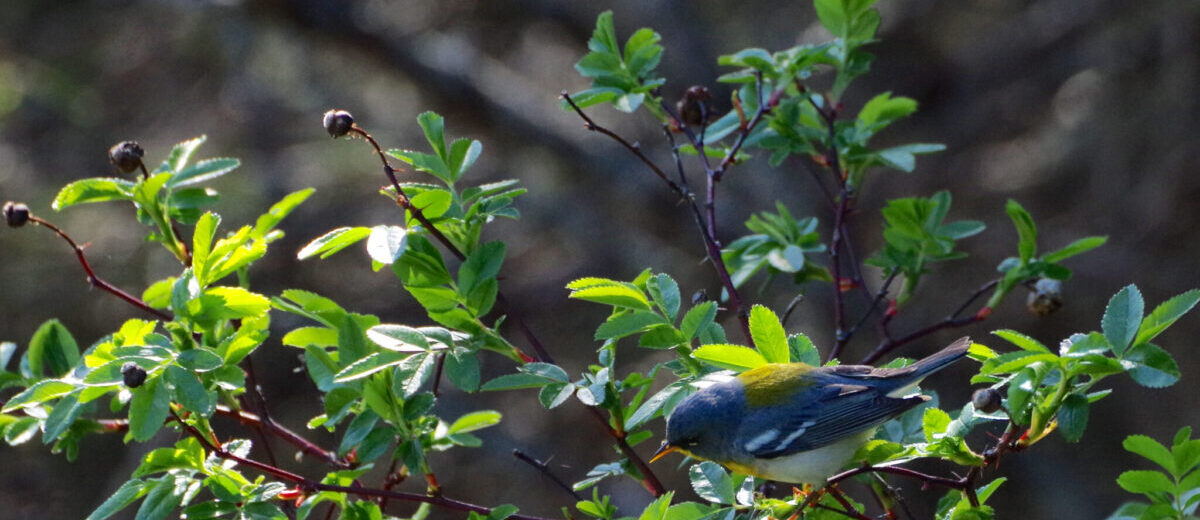story + photos by Catherine Schmitt
There is a long history of people watching and listening to birds on Mount Desert Island. Stories passed down through generations, specimens preserved in natural history collections, and carefully archived records present a baseline against which we can document the changes occuring in bird populations and their habitat in Acadia National Park and the surrounding region.
In the early 1880s, members of the Champlain Society, a group of student naturalists, compiled a list of 97 species found on Mount Desert Island during the summer months. In the case of warblers and other migratory songbirds, they were documenting breeding or nesting birds. Are these same species breeding in the same locations 140 years later? This is an outstanding question that YOU can help us answer.
As part of the Landscape of Change project, we are asking people to help us re-visit historic bird records.
The Champlain Society Ornithology Department often collected while hiking through the woods of Mount Desert Island. In celebration of National Trails Day and Black Birders Week, here are a few suggested routes in Acadia National Park and other conservation lands, and what birds to look (and listen) for.
Note that parking at trailheads in Acadia National Park can be extremely challenging. Arrive early or late in the day, and have a back-up plan in case parking lots are full.
Please share your findings using eBird or this form, and please sign up to let us know you are participating, and receive updates on the Landscape of Change project.
Norumbega Mountain
The Champlain Society camped in Northeast Harbor, and often hiked Norumbega Mountain (then called Brown’s or Brown Mountain), where they found Common Nighthawk, White-throated Sparrow, and Nashville Warbler. Hike up via Lower Hadlock Pond or the Golf Course Trail.
Hadlock Ponds
Beginning at Lower Hadlock Pond, look for Canada Warbler and Yellow-bellied Flycatcher in wet, shrubby areas. At Upper Hadlock Pond, check the shoreline for Solitary Sandpiper, and listen for Northern Parula and Blue-headed Vireo.
Asticou
In 1882 the Champlain Society moved their camp from Somes Sound to the head of Northeast Harbor, near the current site of the Asticou Inn. From the shore they documented Black-crowned Night Heron, Osprey, Red-tailed Hawk, Broad-Winged Hawk, Purple Martin, and Blue Jay. They recorded Black-throated Blue Warbler, Blackburnian Warbler, and Winter Wren in the surrounding woods, which today can be accessed via the Asticou-Jordan Pond Path and trails tended by the Land & Garden Preserve.
Jordan Pond
Extend a walk from Asticou along the historic Jordan Pond Path, take the carriage roads, or follow trails from Jordan Pond House into the surrounding woods at dusk, listening for calls of Eastern Whip-poor-will and Wood Thrush.
Sargent Mountain
Hike up the Maple Spring and Grandgent trails, and listen for the call of Swainson’s Thrush. Julius R. Wakefield found a nest ten feet up in a birch high up in the gorge in July 1883.

Echo Lake
Charles Townsend saw a Boreal Chickadee near Echo Lake on August 23, 1882. Check the woods near Echo Lake beach and parking area, or travel up the Beech Cliffs Trail. Paddlers can check the shoreline toward the northern end of the lake.
Southwest Harbor
Look for Bay-breasted Warbler and Golden-crowned Kinglets around Southwest Harbor, perhaps while visiting the Wendell Gilley Museum or Charlotte Rhoades Butterfly Garden. Henry Spelman found these birds while exploring the Norwood Cove area. Charles Townsend also saw an Eastern Bluebird in downtown Southwest Harbor.
Northeast Harbor
The Champlain Society’s initial campsite is now occupied by private properties and the Northeast Harbor Golf Club. However, the Northeast Harbor Village Improvement Society maintains a network of trails between downtown and Lower Hadlock Pond, and the area may still host: Brown Creeper, Downy and Hairy Woodpeckers, Hermit Thrush, Chipping Sparrow, Magnolia Warbler, Nashville Warbler, Yellow Warbler, Yellow-Rumped Warbler, Chestnut-sided Warbler, Alder Flycatcher, and Barred Owls.
Remember to share your findings using eBird or this form, and thank you for helping to document this Landscape of Change!
